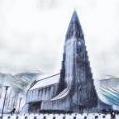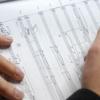Search the Community
Showing results for tags 'modal'.
-
This is the result of an art trade (or collab) I did with Michellle Walker (an artist who draws). The point of the piece is to describe some kind of mysterious and nostalgic atmosphere. (I have spent more time in this piece than what I'm willing to admit.) This piece is a bit experimental from a formal point of view. The idea was to set all the main motifs of the whole piece in very few measures (basically the introduction) and then develope them in some kind of improvisational style. So basically the consistency of the work comes from the constant use of these little elements and the aesthetic of the whole piece. I also make use of recurrent motifs you can find in other works by me, like the one/s you can see between measure 2 and 3. (I hope I'm not repeating myself too much haha.) The first motif can be seen in my Memories piece and the other one is based in the same intervals as the main theme in "Gwyn, Lord of Cinder." And interestingly combining both creates some kind of mutated version of the first theme in the 3rd movement of Brahms' 3rd symphony. I got a lot of inspiration from Scriabin and you can see his mystic chord in some occasions. (At least the main harmony of the chord.) The idea was to create some kind of impressionistic piece with Chopinesque and jazz hues. And I also used a progression in measure 15 that pretty much comes from a madrigal by Gesualdo ("Moro lasso"). The best part of the piece is probably around measures 21-24. (In my opinion.) That climax and the sweet chords that descend are inspired in Debussy. Other inspirations are Ravel, Brahms and jazz in general. By the way, this is probably my best looking piano score I have ever done, and I'm quite proud about that. Anyways, I hope you will enjoy it and I'm open to criticism and feedback.
-
Hello again, friends. I've been in sort of a composing funk for the past few months, lots of life stressors and, really, an utter lack of motivation to blame. I was hoping to write something on a grander scale but I had to settle for solo piano once again. You know what they say: beggars can't be choosers. This is the opening prelude to what will likely become another suite for piano. It's written in harmonic language derived from non-heptatonic scales (my favorite, as some of you know by now), and, as such, may sound unpleasantly dissonant. The chords are quartal or quintal rather than triadic, and there's no sense of a home key. It can't quite be classifed as atonal, however, because the note pitches do play a functional role; it is probably best described as modal, which presents a listening experience unusual to ears familiar with tonal harmony. Nevertheless, I hope you find it enjoyable, or at least appreciable. Feedback and comments are always welcome (so are any questions you may have)! Please, enjoy!
-
Hello, all! Here's my most recent composition. This is a more sonorous piano piece, less "dissonant" perhaps, though it's still based on the symmetrical scales of the prelude I posted recently. The title means "silver nocturne," and is intended to be liquid and smooth and placid, like rippling moonlight on a quiet lake. It will likely become incorporated as a "slow" movement into a larger work. The work features motivic, rather than thematic, development; you will notice the same motif weave in and out of the sections. Please let me know what you think of this. I'd love feedback of any kind! (This is a live recording so I do apologize for some of the choppiness in advance.) Happy listening!
-
I set out to challenge myself with this particular work. As chromaticism is a strong component of my musical language -I decided to do away with it for this particular episode. The transitions are more seamless and are derived from fragments of the ending section (something I'm becoming fond of doing, to be honest). The score is a tad messy -but I'll provide a clean copy eventually.
-
Usually, I don't like working on fuges. Although I love counterpoint, and use it all the time, so many rules are not what I like most. So, I wrote this piece using different classic modes, which provide more freedom. FUGA MODAL Partitura completa.pdf FUGA MODAL.mp3
-
This is a short piece based on a nonatonic scale (which has no specific name): C - C# - D - E - F - F# - G - A - B The harmony comes from the combination of the notes of the scale, don't expect "normal" chords. Now I'm working in the second part of the "suite" using this scale.
-
Hi everyone , I have any question :) . Firstly my English is very bad. So I'm sorry . I'm composition student at university and I have scholarship but my class is preparation . My Professor and my friend says my compositions very good but I'm writing tonal music but I cant write contemporary music . example : I cant write Whole tone music or I cant write like Stravinsky . What can I do ? I want to write contemporary music , whole tone and like stravinsky . My Professor said that so early but my other Professor said that you can start contemporary . What can I do ? :) Thak you . I'm sorry for my english is very bad.
- 4 replies
-
- composition
- contemporary
-
(and 2 more)
Tagged with:





